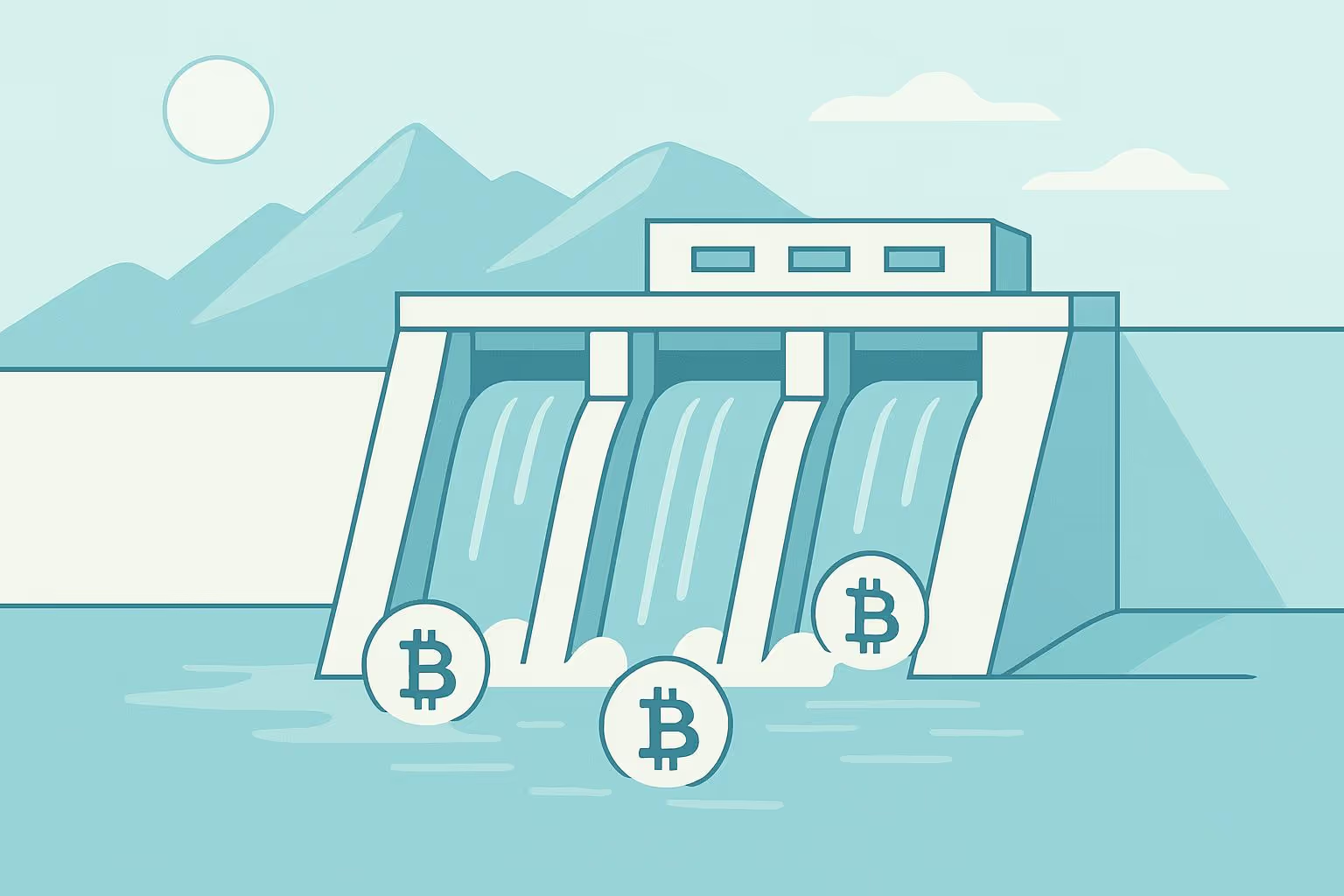Bitcoin’s journey from a niche technological experiment to a global financial innovation has introduced a complex ecosystem of mining operations, energy debates, and economic opportunities. In a recent discussion featuring Kent Halliburton, co-founder and CEO of Sazmining, valuable insights emerged about how renewable energy, decentralization, and individual empowerment are reshaping the Bitcoin mining landscape. The conversation also highlighted how mining operations can align sustainability goals with profitability and foster a robust, decentralized Bitcoin network.
This article delves into the key themes from the conversation, including the intersection of Bitcoin mining and renewable energy, decentralization through individual participation, and the transformative role of mining as a service.
The Role of Renewable Energy in Bitcoin Mining
Why Renewable Energy Matters
Bitcoin mining has often come under scrutiny for its energy consumption. However, Halliburton explains that Bitcoin mining and renewable energy are not at odds; rather, they complement each other. The strategic use of underutilized renewable energy sources like hydroelectric power not only reduces carbon footprints but also enhances the stability of power grids.
Halliburton draws parallels between solar energy and Bitcoin mining, both of which are disruptive and decentralized technologies. “Solar is the only way we can create electricity without moving anything,” he notes, emphasizing its long-term reliability. The declining cost of renewable energy, particularly solar and hydroelectric, offers substantial opportunities for mining operations to access clean, consistent power.
Hydropower: A Reliable Backbone for Mining
Hydroelectric power serves as the backbone of Sazmining’s operations. Halliburton highlights regions like Paraguay and Ethiopia, where abundant hydroelectric power is underutilized. For example, Paraguay produces far more electricity than it consumes, exporting the surplus at a loss. By establishing mining operations in these areas, Bitcoin miners help monetize surplus energy, increase local GDP, and create infrastructure that benefits communities long after mining operations cease.
This model also ensures mining profitability by securing low-cost energy while simultaneously addressing the global push for sustainability.
Bitcoin Mining as an Economic Engine
Transforming Local Economies
Bitcoin mining can be a game-changer for regions with surplus energy. Halliburton explains that in countries like Ethiopia, Bitcoin mining generates foreign currency that governments use to service international debts. This unique ability to convert unused energy into a monetizable asset creates economic opportunities in regions that might otherwise face energy wastage or financial constraints.
Industrial Infrastructure Legacy
Mining doesn’t just leave behind Bitcoin—it creates infrastructure. Substations, high-tension lines, and energy grids built for mining operations can later serve other industries, enabling economic diversification. In Paraguay, for instance, Bitcoin mining has laid the groundwork for heavy manufacturing and other industries to flourish.
Decentralizing the Bitcoin Network with Individual Participation
From Fiat Hashers to Bitcoiners
One of the central themes of the conversation is decentralizing hash rate ownership to align with Bitcoin’s ethos. According to Halliburton, much of the network’s hash rate today is controlled by large, publicly traded companies focused on fiat returns rather than Bitcoin’s principles. He argues that this "fiat mindset" contributes to centralization risks, as decisions made by these companies prioritize shareholder value over network integrity.
By empowering individuals to mine Bitcoin, Sazmining seeks to decentralize hash rate ownership and reduce the network’s vulnerability to centralization risks. “We’ve seeded the network to fiat hashers,” Halliburton explains. “Reclaiming it through individual participation strengthens the social layer of Bitcoin and aligns incentives.”
Mining as a Service: Empowering Individuals
Sazmining’s approach is rooted in the concept of mining as a service, combining hardware ownership with hands-off management. Customers own individual mining rigs, while SAS handles site selection, operations, and maintenance. This model allows individuals to secure non-KYC Bitcoin (i.e., Bitcoin not tied to identity verification processes) without the technical complexity of managing mining operations themselves.
Halliburton emphasizes that this model builds trust by aligning incentives. SAS only receives its management fee—a percentage of the Bitcoin mined—if the mining rigs perform well. This alignment ensures transparency and motivates SAS to maximize uptime and efficiency.
Decentralizing Mining Pools: The Role of Ocean
Addressing Pool Centralization
Mining pool centralization poses a significant risk to Bitcoin’s security. Halliburton underscores the issue, noting that two pools—Foundry and Antpool—control nearly half of the network’s hash rate. Such concentration creates censorship risks and could theoretically enable malicious actors to disrupt the network.
To combat this, Sazmining partnered with the Ocean mining pool, which prioritizes decentralization. Customers can now choose to direct their hash rate to Ocean, providing an alternative to larger, centralized pools.
A Milestone: Finding a Block
Recently, a mining rig hosted by Sazmining found a block—an achievement celebrated by both the company and the individual miner. Halliburton describes the moment as a visceral connection to the network’s purpose. “Mining is where reality hits Bitcoin,” he says, emphasizing the importance of empowering individuals to participate in securing the Bitcoin network.
The Evolution of Bitcoin Mining Technology
The Promise of Innovation
The next frontier in mining decentralization lies in hardware innovation. Halliburton discussed the demand for new high-efficiency mining rigs like those produced by Proto, a Square initiative. Such innovations could lower the barrier to entry for individual miners while reducing hardware centralization.
Harnessing Waste Heat
Another avenue for innovation is integrating mining rigs into heating systems. Halliburton notes that Bitcoin mining could replace traditional space heaters, turning wasted energy into a source of income. This approach could decentralize mining further by encouraging widespread adoption of household-scale rigs.
Key Takeaways
- Renewable Energy Integration: Bitcoin mining pairs well with renewable energy sources like hydro and solar, reducing carbon footprints and enhancing energy grid stability.
- Economic Transformation: Mining operations in energy-rich regions can monetize surplus energy, boost GDP, and create lasting industrial infrastructure.
- Empowering Individuals: Sazmining’s mining-as-a-service model allows individuals to mine Bitcoin without managing hardware, fostering decentralization.
- Addressing Pool Centralization: By partnering with decentralized pools like Ocean, Sazmining gives its customers a choice and reduces centralization risks.
- The Importance of Decentralization: Encouraging individual participation in mining strengthens Bitcoin’s network and aligns incentives with its principles.
- Hardware and Heating Innovations: New mining rigs and integrated heating solutions could further democratize Bitcoin mining, making it accessible to more people.
Conclusion
Bitcoin mining is undergoing a transformative shift, driven by the integration of renewable energy, decentralization efforts, and technological innovation. Sazmining approach demonstrates that aligning sustainability with profitability is not only possible but essential for the network’s future.
As Halliburton aptly put it, “Bitcoin mining is where reality meets Bitcoin.” By empowering individuals to participate in the network, Bitcoiners collectively ensure its resilience and adherence to its decentralized ethos. The next chapter of Bitcoin mining will depend on how the community leverages these opportunities to address existing risks and build a more robust, decentralized network.
Source: "The Best Way to Acquire Bitcoin | Center of Hash E010" — TFTC, YouTube, Oct 21, 2025 — https://www.youtube.com/watch?v=JRd_IxYZiAg

